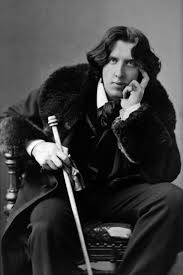Are you tired of reading poems that force you to look at countless footnotes to understand their socio-political significance? Are your eyes hurting from staring at the same poem over and over again trying to decipher its “deep meaning” or religious importance? If you answered yes (or just stared unresponsively at these questions) then the Aestheticism School of Poetry is definitely perfect for you. It’s decadence, luxuriousness, beauty, and rich imagery makes Aestheticism the dessert of literature. Our Founder, Walter Pater, was a British writer who heavily influenced aesthetic writers in their work. In his essays Studies in the History of the Renaissance, which was published between 1867 and 1868, he said “life has to be lived intensely, with an ideal of beauty.” These essays began the principle of “Art for Art’s Sake,” or in other words, using art to convey something beautiful rather than trying to bring about some sort of political, social, or religious debate.
Think of your favorite song (hopefully it has lyrics). Now strip away the music elements and break it down to just the words. Do they still sound beautiful? This idea of lyricism as art was very important to this poetic school. Lyric poetry was actually seen as the most valued aesthetic poetry because being pleasing to the ear was the main goal.
To better understand the mindset of the poets of this movement, let us think of them as high schoolers at a lunch.
On the right side of the table, we have Aristotle and Sir Philip Sidney. These upperclassmen look down upon the curious and playful nature of their younger counterparts. Every single day they dress identically and eat the same food as each other because imitation is everything to them. They synchronize their breathing, their steps and even their thoughts. If Sidney were to pick up and apple after Aristotle grabbed an orange, they might go a week without speaking. Eventually they would get over themselves though because who else would they have to mimic?
Aristotle and Sidney can’t stand those weird kids that sit outside every single day during lunchtime.
The names of those weirdos are Wordsworth, Blake, Coleridge and Keats. They don’t even eat. Staring at the trees and flowers is enough for them. It’s all they talk about when they go back to class. It’s almost like a sport: who can love nature and their surroundings the most? They probably use photosynthesis to generate the energy to constantly think about their love for nature
Then there’s Wilde and Swinburne: the rich kids.

 It would not be a normal day at school if they purchased a school lunch. That would be embarrassing. Instead they invite their personal cooks to lunch hour everyday to prepare the finest meals. They always have backup cashmere robes in case a bit of food brushes up against the ones they are wearing. Why do they dress up so extravagantly to school each day? Their answer is: why not! Sometimes they’ll be seen whining over the fact that their full symphony is late to lunch. They try not to dwell on their absence though since they know they will hear their gorgeous music as soon as they get home and eat their afternoon snack. The constantly make fun of the preps, Sidney and Aristotle. They like to call these preps “the twins”, since they aren’t happy unless they buy everything from the same stores. They sort of like the romantics eating outside because of their appreciation of beauty, but they don’t quite contain the level of lavishness needed to be accepted by these two.
It would not be a normal day at school if they purchased a school lunch. That would be embarrassing. Instead they invite their personal cooks to lunch hour everyday to prepare the finest meals. They always have backup cashmere robes in case a bit of food brushes up against the ones they are wearing. Why do they dress up so extravagantly to school each day? Their answer is: why not! Sometimes they’ll be seen whining over the fact that their full symphony is late to lunch. They try not to dwell on their absence though since they know they will hear their gorgeous music as soon as they get home and eat their afternoon snack. The constantly make fun of the preps, Sidney and Aristotle. They like to call these preps “the twins”, since they aren’t happy unless they buy everything from the same stores. They sort of like the romantics eating outside because of their appreciation of beauty, but they don’t quite contain the level of lavishness needed to be accepted by these two.
One of Oscar Wilde’s favorite quotes is, “Who want’s to be consistent.” Change is everything to these poets. Unusual outfits, literature, and even sexuality was characteristic of Wilde who was in the homosexual minority, an offense punishable by law during the 1800s. In this example excerpt of “Flower of Love”, you can sense the beauty of his words simply for the sake of enjoyment, pleasure, or entertainment.
“And at springtide, when the apple-blossoms brush the burnished bosom of the dove,
Two young lovers lying in an orchard would have read the story of our love;
Would have read the legend of my passion, known the bitter secret of my heart,
Kissed as we have kissed, but never parted as we two are fated now to part.
For the crimson flower of our life is eaten by the cankerworm of truth,
And no hand can gather up the fallen withered petals of the rose of youth.”
I think it’s safe to say that “Art for Art’s Sake” has paved the way for entertainment today. I mean how else can we justify shows like The Bachelor.
Sources:
“Aestheticism.” Victorian Poetry, Poetics and Contexts – Aestheticism. N.p., n.d. Web. 09 Feb. 2017.
“Aestheticism.” Victorian Poetry, Poetics and Contexts – Aestheticism. N.p., n.d. Web. 09 Feb. 2017.
“Obo.” Aestheticism – Victorian Literature – Oxford Bibliographies. N.p., 06 Jan. 2017. Web. 09 Feb. 2017.
“Oscar Wilde and the Aesthetic Movement.” Oscar Wilde and the Aesthetic Movement. N.p., n.d. Web. 09 Feb. 2017.
“Poetry through the Ages.” Business of Poetry : Poetry through the Ages. N.p., n.d. Web. 09 Feb. 2017.
“Rossetti Archive Pictures.” Rossetti Archive Paintings, Drawings, and Designs Exhibit. N.p., n.d. Web. 09 Feb. 2017.
“Why “Mean Girls” Is a Classic.” The New Yorker. The New Yorker, 16 July 2014. Web. 12 Feb. 2017.


